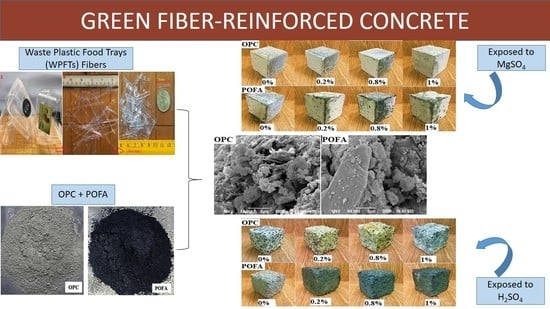Performance Evaluation of Sustainable Concrete Comprising Waste Polypropylene Food Tray Fibers and Palm Oil Fuel Ash Exposed to Sulfate and Acid Attacks
Abstract
:1. Introduction
2. Experimental Program
2.1. Materials
2.2. Formulation of the Experimental Prototype
2.3. Testing Methods
3. Results and Discussion
3.1. Workability
3.2. Water-cured Compressive Strength
3.3. Sulfate Attack
3.3.1. Visual Assessment
3.3.2. Mass Gain
3.3.3. Compressive Strength Loss
3.4. Sulfate Attack
3.4.1. Visual Assessment
3.4.2. Mass Loss
3.4.3. Strength Loss
3.5. Scanning Electron Microscopy Analysis
4. Conclusions
- Adding WPFT fibers into the concrete mixture resulted in a reduction in workability. The addition of 1% fibers resulted in a slump value of 35 mm, which is comparatively lower than that of the 185 mm which was obtained for plain concrete mix.
- The compressive strength reduced as the fiber dosage increased. Initially, the strength improvement of POFA mixes was essentially identical to that of OPC concrete mixes. POFA-based concrete mixtures had higher compressive strength than OPC concrete mixtures after extended curing times. At 365 days, the obtained compressive strength values for POFA concrete mixes ranged from 42 MPa to 52.9 MPa, which is higher than the values reported for OPC mixes. POFA’s pozzolanic activity, which produces additional hydration products, can account for the higher strength values in POFA mixes.
- After being exposed to acid, the mass variation of plain and reinforced concrete specimens was negative, whereas the mass variation of sulfate-treated samples was positive. The rate of mass change in mixtures comprising WPFT fiber and POFA, on the other hand, was lower than that in the OPC combinations. Adding WPFT fibers to concrete exposed to chemical attacks was a good technique for controlling mass changes. The mass loss of POFA concrete specimens reinforced with 1% fibers after 12 months of exposure in the H2SO4 solution was recorded as 3.5%, which is comparatively lower than that of the 15.5% recorded for the plain concrete without fibers.
- Adding WPFT fibers and POFA to concrete specimens improved their sulfate resistance. Due to the bridging action, the presence of WPFT fibers reduced expansion and crack development, whereas the control specimen expanded due to the high calcium oxide content in the sulfate solution. Consequently, a concrete mixture containing 0.4% WPFT fibers and 30% POFA exposed to sulfate has excellent potential for reducing compressive strength loss to only 3.7 MPa.
- Concrete specimens containing POFA and WPFT fibers showed a respectable level of acid resistance. Concrete’s acid resistance rose as the fiber volume percentage grew. It was discovered that concrete comprising 1% WPFT fibers and 30% POFA had a compressive strength loss of 19.9 MPa, which is comparatively lesser than that of the 31.4 MPa noted for the control mix.
- Due to the increased CaO content in ordinary Portland cement, the deterioration of OPC-based concrete mixtures was more severe and quicker than that of the POFA mixtures exposed to aggressive environments.
- SEM analysis of the pastes treated with 10% MgSO4 and 5% H2SO4 solutions revealed how the specimens changed in these harsh conditions. As a result of exposure, the pores of the OPC matrix eventually filled up with other precipitated elements. Furthermore, in the POFA mixtures, most voids were filled with these products due to POFA’s pozzolanic action and additional C-S-H gel, especially at later ages, which developed the performance of the concrete.
- Concrete made from waste plastic food tray fibers and palm oil fuel could be commercialized and used to develop industrial structures and other similar uses where high resistance to harsh environments is required.
Author Contributions
Funding
Data Availability Statement
Acknowledgments
Conflicts of Interest
References
- Gu, L.; Ozbakkaloglu, T. Use of recycled plastics in concrete: A critical review. Waste Manag. 2016, 51, 19–42. [Google Scholar] [CrossRef]
- Wu, S.; Montalvo, L. Repurposing waste plastics into cleaner asphalt pavement materials: A critical literature review. J. Clean. Prod. 2020, 280, 124355. [Google Scholar] [CrossRef]
- Eriksen, M.; Christiansen, J.; Daugaard, A.E.; Astrup, T. Closing the loop for PET, PE and PP waste from households: Influence of material properties and product design for plastic recycling. Waste Manag. 2019, 96, 75–85. [Google Scholar] [CrossRef]
- Hearn, G.; Ballard, J. The use of electrostatic techniques for the identification and sorting of waste packaging materials. Resour. Conserv. Recycl. 2005, 44, 91–98. [Google Scholar] [CrossRef]
- Blanco, I. Lifetime prediction of food and beverage packaging wastes. J. Therm. Anal. Calorim. 2016, 125, 809–816. [Google Scholar] [CrossRef]
- Silvestre, C.; Duraccio, D.; Cimmino, S. Food packaging based on polymer nanomaterials. Prog. Polym. Sci. 2011, 36, 1766–1782. [Google Scholar] [CrossRef]
- Martino, V.; Ruseckaite, R.; Jiménez, A. Thermal and mechanical characterisation of plasticised poly (L-lactide-co-D, L-lactide) films for food packaging. J. Therm. Anal. Calorim. 2006, 86, 707–712. [Google Scholar] [CrossRef]
- Mohammadhosseini, H.; Yatim, J.M.; Sam, A.R.M.; Awal, A.A. Durability performance of green concrete composites containing waste carpet fibers and palm oil fuel ash. J. Clean. Prod. 2017, 144, 448–458. [Google Scholar] [CrossRef]
- Alqahtani, F.K.; Abotaleb, I.S.; ElMenshawy, M. Life cycle cost analysis of lightweight green concrete utilizing recycled plastic aggregates. J. Build. Eng. 2021, 40, 102670. [Google Scholar] [CrossRef]
- Mohammadhosseini, H.; Yatim, J.M. Microstructure and residual properties of green concrete composites incorporating waste carpet fibers and palm oil fuel ash at elevated temperatures. J. Clean. Prod. 2017, 144, 8–21. [Google Scholar] [CrossRef]
- Hubo, S.; Leite, L.; Martins, C.; Ragaert, K. Evaluation of post-industrial and post-consumer polyolefin-based polymer waste streams for injection moulding. In Proceedings of the 6th Polymers & Mould Innovations International Conference, Guimaraes, Portugal, 10–12 September 2014; pp. 201–206. [Google Scholar]
- Kumar, S.; Panda, A.K.; Singh, R. A review on tertiary recycling of high-density polyethylene to fuel. Resour. Conserv. Recycl. 2011, 55, 893–910. [Google Scholar] [CrossRef]
- Siddique, R.; Khatib, J.; Kaur, I. Use of recycled plastic in concrete: A review. Waste Manag. 2008, 28, 1835–1852. [Google Scholar] [CrossRef] [PubMed]
- Almeshal, I.; Tayeh, B.A.; Alyousef, R.; Alabduljabbar, H.; Mohamed, A.M.; Alaskar, A. Use of recycled plastic as fine aggregate in cementitious composites: A review. Constr. Build. Mater. 2020, 253, 119146. [Google Scholar] [CrossRef]
- Alyousef, R.; Mohammadhosseini, H.; Alrshoudi, F.; Alabduljabbar, H.; Mohamed, A.M. Enhanced performance of concrete composites comprising waste metalised polypropylene fibres exposed to aggressive environments. Crystals. 2020, 10, 696. [Google Scholar] [CrossRef]
- Mohammadhosseini, H.; Alyousef, R.; Tahir, M.M. Towards Sustainable Concrete Composites through Waste Valorisation of Plastic Food Trays as Low-Cost Fibrous Materials. Sustainability. 2021, 13, 2073. [Google Scholar] [CrossRef]
- Alrshoudi, F.; Mohammadhosseini, H.; Alyousef, R.; Alabduljabbar, H.; Mustafa Mohamed, A. The impact resistance and deformation performance of novel pre-packed aggregate concrete reinforced with waste polypropylene fibres. Crystals. 2020, 10, 788. [Google Scholar] [CrossRef]
- Mohammadhosseini, H.; Ngian, S.P.; Alyousef, R.; Tahir, M.M. Synergistic effects of waste plastic food tray as low-cost fibrous materials and palm oil fuel ash on transport properties and drying shrinkage of concrete. J. Build. Eng. 2021, 42, 102826. [Google Scholar] [CrossRef]
- Jain, A.; Siddique, S.; Gupta, T.; Jain, S.; Sharma, R.K.; Chaudhary, S. Evaluation of concrete containing waste plastic shredded fibers: Ductility properties. Struct. Concr. 2021, 22, 566–575. [Google Scholar] [CrossRef]
- Colangelo, F.; Cioffi, R.; Liguori, B.; Iucolano, F. Recycled polyolefins waste as aggregates for lightweight concrete. Compos. Part B Eng. 2016, 106, 234–241. [Google Scholar] [CrossRef]
- Sotiriadis, K.; Nikolopoulou, E.; Tsivilis, S. Sulfate resistance of limestone cement concrete exposed to combined chloride and sulfate environment at low temperature. Cem. Concr. Compos. 2012, 34, 903–910. [Google Scholar] [CrossRef]
- Mohammadhosseini, H.; Tahir, M.M.; Sam, A.R.M.; Lim, N.H.A.S.; Samadi, M. Enhanced performance for aggressive environments of green concrete composites reinforced with waste carpet fibers and palm oil fuel ash. J. Clean. Prod. 2018, 185, 252–265. [Google Scholar] [CrossRef]
- Bulatović, V.; Melešev, M.; Radeka, M.; Radonjanin, V.; Lukić, I. Evaluation of sulfate resistance of concrete with recycled and natural aggregates. Constr. Build. Mater. 2017, 152, 614–631. [Google Scholar] [CrossRef]
- Wu, F.; Yu, Q.; Liu, C.; Brouwers, H.J.H.; Wang, L.; Liu, D. Effect of fibre type and content on performance of bio-based concrete containing heat-treated apricot shell. Mater. Struct. 2020, 53, 1–16. [Google Scholar] [CrossRef]
- Neville, A. The confused world of sulfate attack on concrete. Cem. Concr. Res. 2004, 34, 1275–1296. [Google Scholar] [CrossRef]
- Hill, J.; Byars, E.; Sharp, J.; Lynsdale, C.; Cripps, J.; Zhou, Q. An experimental study of combined acid and sulfate attack of concrete. Cem. Concr. Compos. 2003, 25, 997–1003. [Google Scholar] [CrossRef]
- Hadigheh, S.A.; Gravina, R.; Smith, S. Effect of acid attack on FRP-to-concrete bonded interfaces. Constr. Build. Mater. 2017, 152, 285–303. [Google Scholar] [CrossRef]
- Lu, C.; Zhou, Q.; Wang, W.; Wei, S.; Wang, C. Freeze-thaw resistance of recycled aggregate concrete damaged by simulated acid rain. J. Clean. Prod. 2021, 280, 124396. [Google Scholar] [CrossRef]
- Mohammadhosseini, H.; Tahir, M.M. Durability performance of concrete incorporating waste metalized plastic fibres and palm oil fuel ash. Constr. Build. Mater. 2018, 180, 92–102. [Google Scholar] [CrossRef]
- Bankir, M.B.; Sevim, U.K. Performance optimization of hybrid fiber concretes against acid and sulfate attack. J. Build. Eng. 2020, 32, 101443. [Google Scholar] [CrossRef]
- Meng, C.; Li, W.; Cai, L.; Shi, X.; Jiang, C. Experimental research on durability of high-performance synthetic fibers reinforced concrete: Resistance to sulfate attack and freezing-thawing. Constr. Build. Mater. 2020, 262, 120055. [Google Scholar] [CrossRef]
- Guo, L.; Wu, Y.; Xu, F.; Song, X.; Ye, J.; Duan, P.; Zhang, Z. Sulfate resistance of hybrid fiber reinforced metakaolin geopolymer composites. Compos. Part B Eng. 2020, 183, 107689. [Google Scholar] [CrossRef]
- Mohammadhosseini, H.; Alyousef, R.; Lim, N.H.A.S.; Tahir, M.M.; Alabduljabbar, H.; Mohamed, A.M.; Samadi, M. Waste metalized film food packaging as low cost and ecofriendly fibrous materials in the production of sustainable and green concrete composites. J. Clean. Prod. 2020, 258, 120726. [Google Scholar] [CrossRef]
- Behfarnia, K.; Farshadfar, O. The effects of pozzolanic binders and polypropylene fibers on durability of SCC to magnesium sulfate attack. Constr. Build. Mater. 2013, 38, 64–71. [Google Scholar] [CrossRef]
- Bolat, H.; Şimşek, O.; Çullu, M.; Durmuş, G.; Can, Ö. The effects of macro synthetic fiber reinforcement use on physical and mechanical properties of concrete. Compos. Part B Eng. 2014, 61, 191–198. [Google Scholar] [CrossRef]
- Guo, X.; Xiong, G. Resistance of fiber-reinforced fly ash-steel slag based geopolymer mortar to sulfate attack and drying-wetting cycles. Constr. Build. Mater. 2021, 269, 121326. [Google Scholar] [CrossRef]
- Turk, K.; Bassurucu, M.; Bitkin, R.E. Workability, strength and flexural toughness properties of hybrid steel fiber reinforced SCC with high-volume fiber. Constr. Build. Mater. 2021, 266, 120944. [Google Scholar] [CrossRef]
- Li, K.; Yang, C.; Huang, W.; Zhao, Y.; Wang, Y.; Pan, Y.; Xu, F. Effects of hybrid fibers on workability, mechanical, and time-dependent properties of high strength fiber-reinforced self-consolidating concrete. Constr. Build. Mater. 2021, 277, 122325. [Google Scholar] [CrossRef]
- Bentegri, I.; Boukendakdji, O.; Kadri, E.-H.; Ngo, T.; Soualhi, H. Rheological and tribological behaviors of polypropylene fiber reinforced concrete. Constr. Build. Mater. 2020, 261, 119962. [Google Scholar] [CrossRef]
- Mohammadhosseini, H.; Tahir, M.M.; Alaskar, A.; Alabduljabbar, H.; Alyousef, R. Enhancement of strength and transport properties of a novel preplaced aggregate fiber reinforced concrete by adding waste polypropylene carpet fibers. J. Build. Eng. 2020, 27, 101003. [Google Scholar] [CrossRef]
- Alrshoudi, F.; Mohammadhosseini, H.; Alyousef, R.; Alghamdi, H.; Alharbi, Y.R.; Alsaif, A. Sustainable use of waste polypropylene fibers and palm oil fuel ash in the production of novel prepacked aggregate fiber-reinforced concrete. Sustainability. 2020, 12, 4871. [Google Scholar] [CrossRef]
- Nili, M.; Afroughsabet, V. The effects of silica fume and polypropylene fibers on the impact resistance and mechanical properties of concrete. Constr. Build. Mater. 2010, 24, 927–933. [Google Scholar] [CrossRef]
- Honglei, C.; Zuquan, J.; Penggang, W.; Jianhong, W.; Jian, L. Comprehensive resistance of fair-faced concrete suffering from sulfate attack under marine environments. Constr. Build. Mater. 2021, 277, 122312. [Google Scholar] [CrossRef]
- Li, Y.; Yang, X.; Lou, P.; Wang, R.; Li, Y.; Si, Z. Sulfate attack resistance of recycled aggregate concrete with NaOH-solution-treated crumb rubber. Constr. Build. Mater. 2021, 287, 123044. [Google Scholar] [CrossRef]
- Alrshoudi, F.; Mohammadhosseini, H.; Tahir, M.M.; Alyousef, R.; Alghamdi, H.; Alharbi, Y.; Alsaif, A. Drying shrinkage and creep properties of prepacked aggregate concrete reinforced with waste polypropylene fibers. J. Build. Eng. 2020, 32, 101522. [Google Scholar] [CrossRef]
- Mohammadhosseini, H.; Lim, N.H.A.S.; Tahir, M.M.; Alyousef, R.; Samadi, M.; Alabduljabbar, H.; Mohamed, A.M. Effects of waste ceramic as cement and fine aggregate on durability performance of sustainable mortar. Arab. J. Scie. Eng. 2020, 45, 3623–3634. [Google Scholar] [CrossRef]
- Mohammadhosseini, H.; Alrshoudi, F.; Tahir, M.M.; Alyousef, R.; Alghamdi, H.; Alharbi, Y.R.; Alsaif, A. Durability and thermal properties of prepacked aggregate concrete reinforced with waste polypropylene fibers. J. Build. Eng. 2020, 32, 101723. [Google Scholar] [CrossRef]
- Mohammadhosseini, H.; Alrshoudi, F.; Tahir, M.M.; Alyousef, R.; Alghamdi, H.; Alharbi, Y.R.; Alsaif, A. Performance evaluation of novel prepacked aggregate concrete reinforced with waste polypropylene fibers at elevated temperatures. Constr. Build. Mater. 2020, 259, 120418. [Google Scholar] [CrossRef]

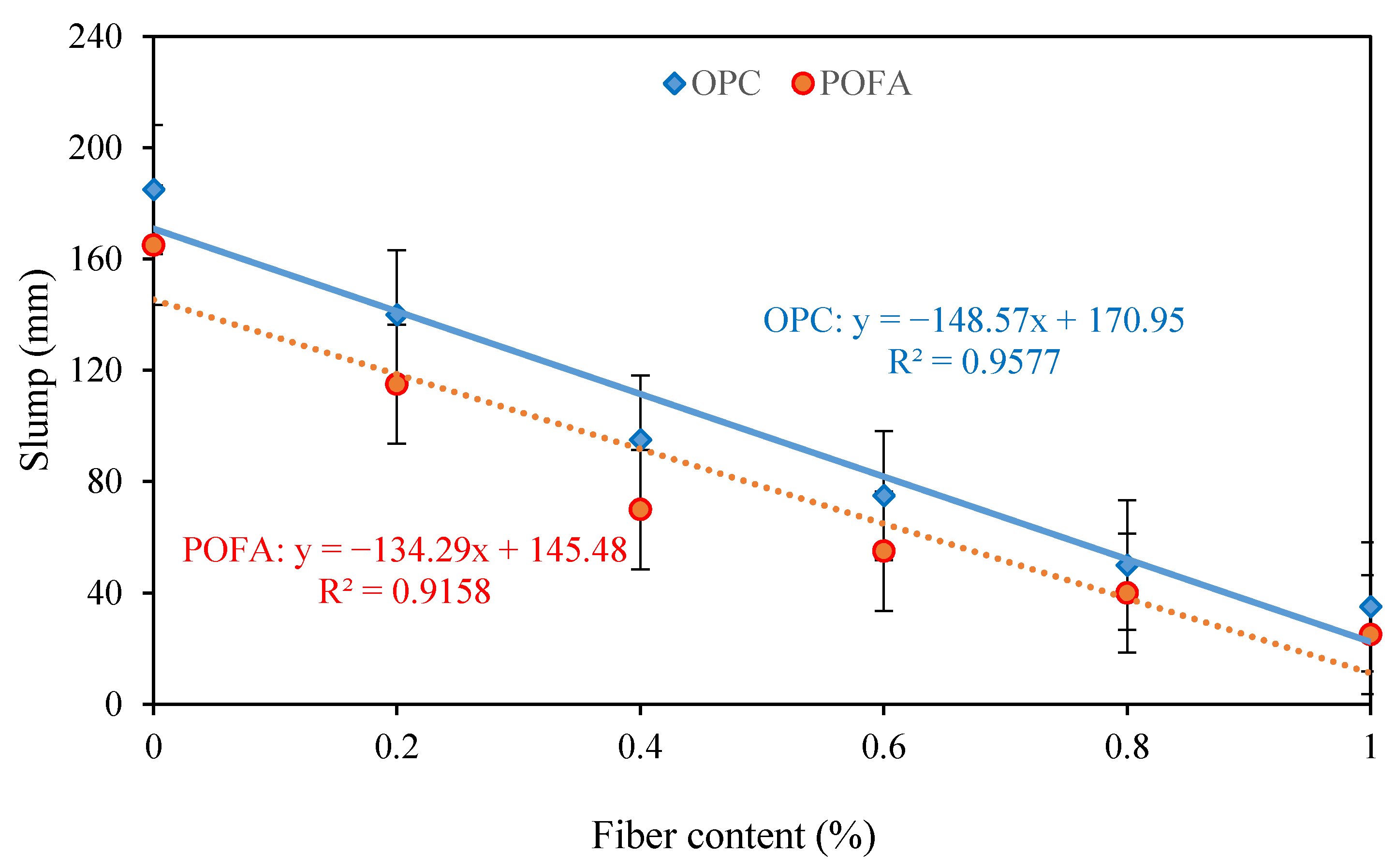
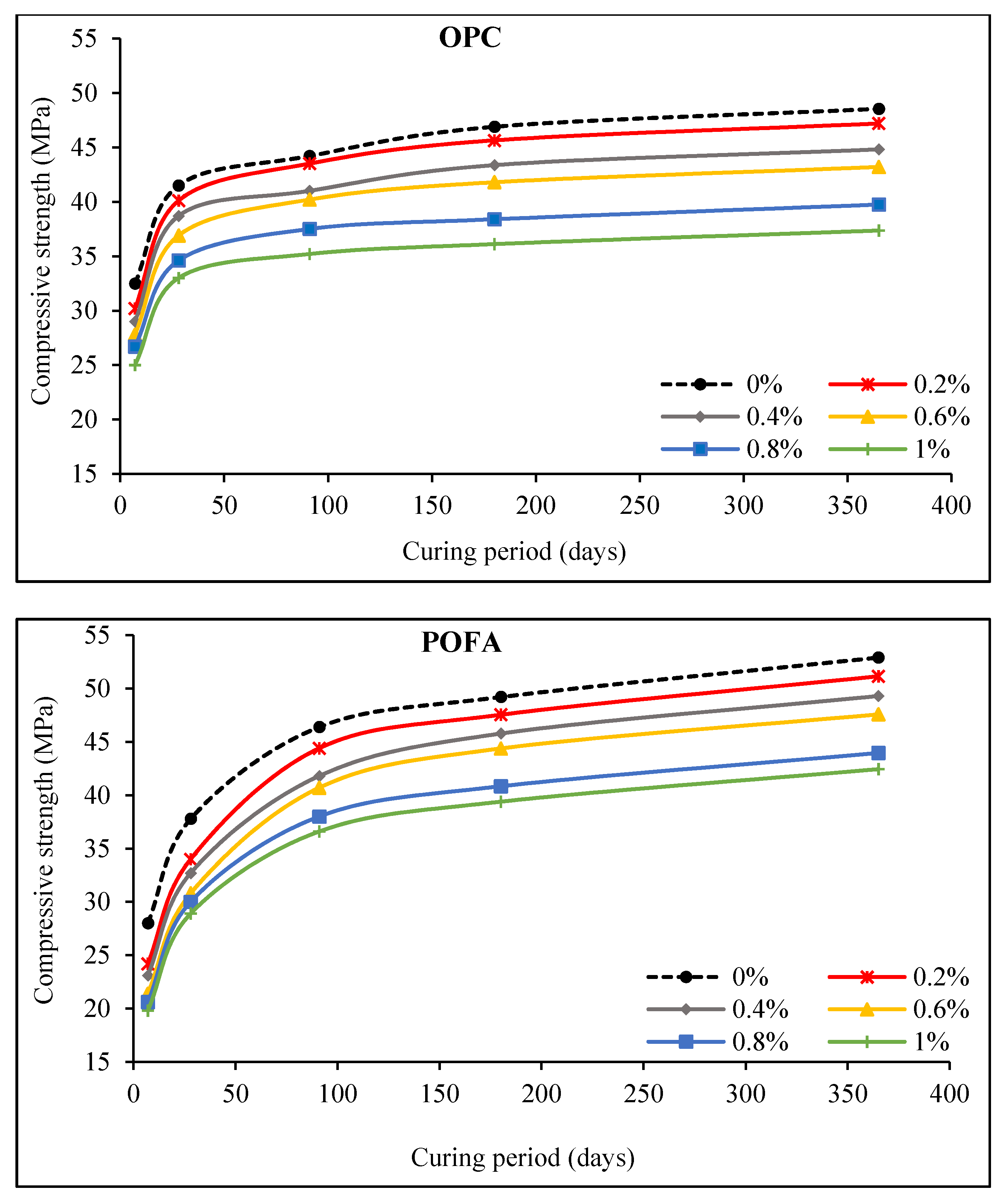
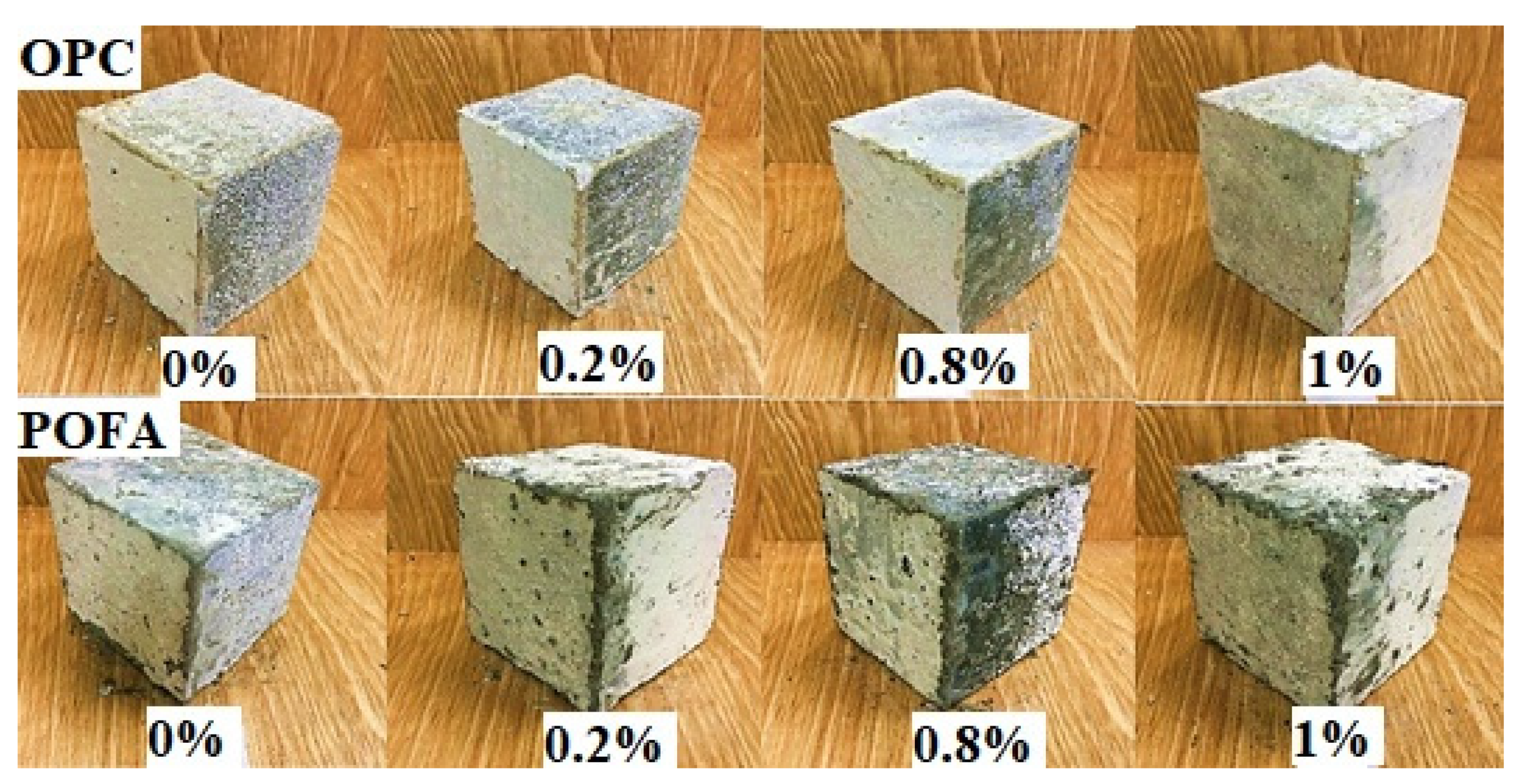
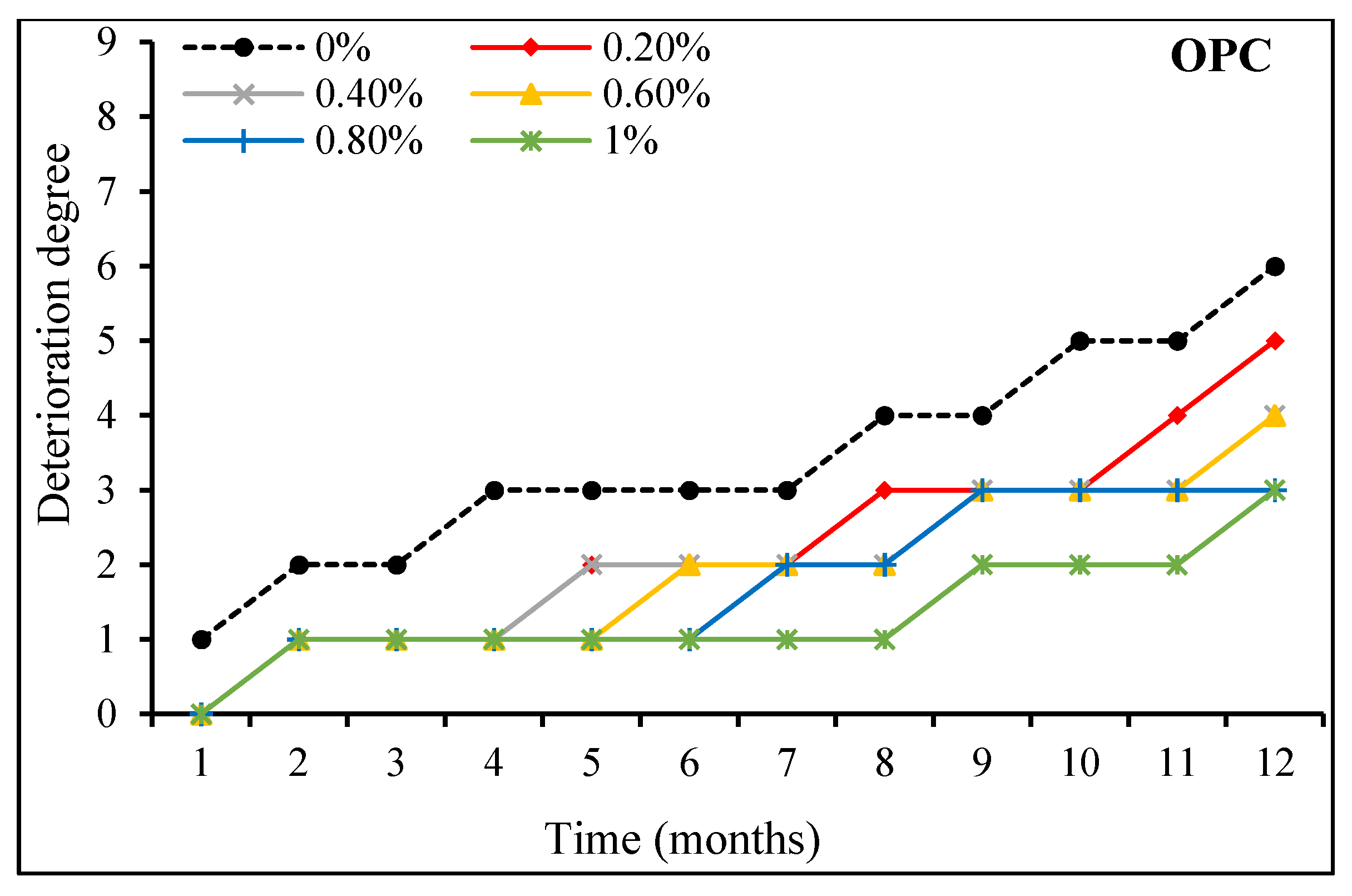


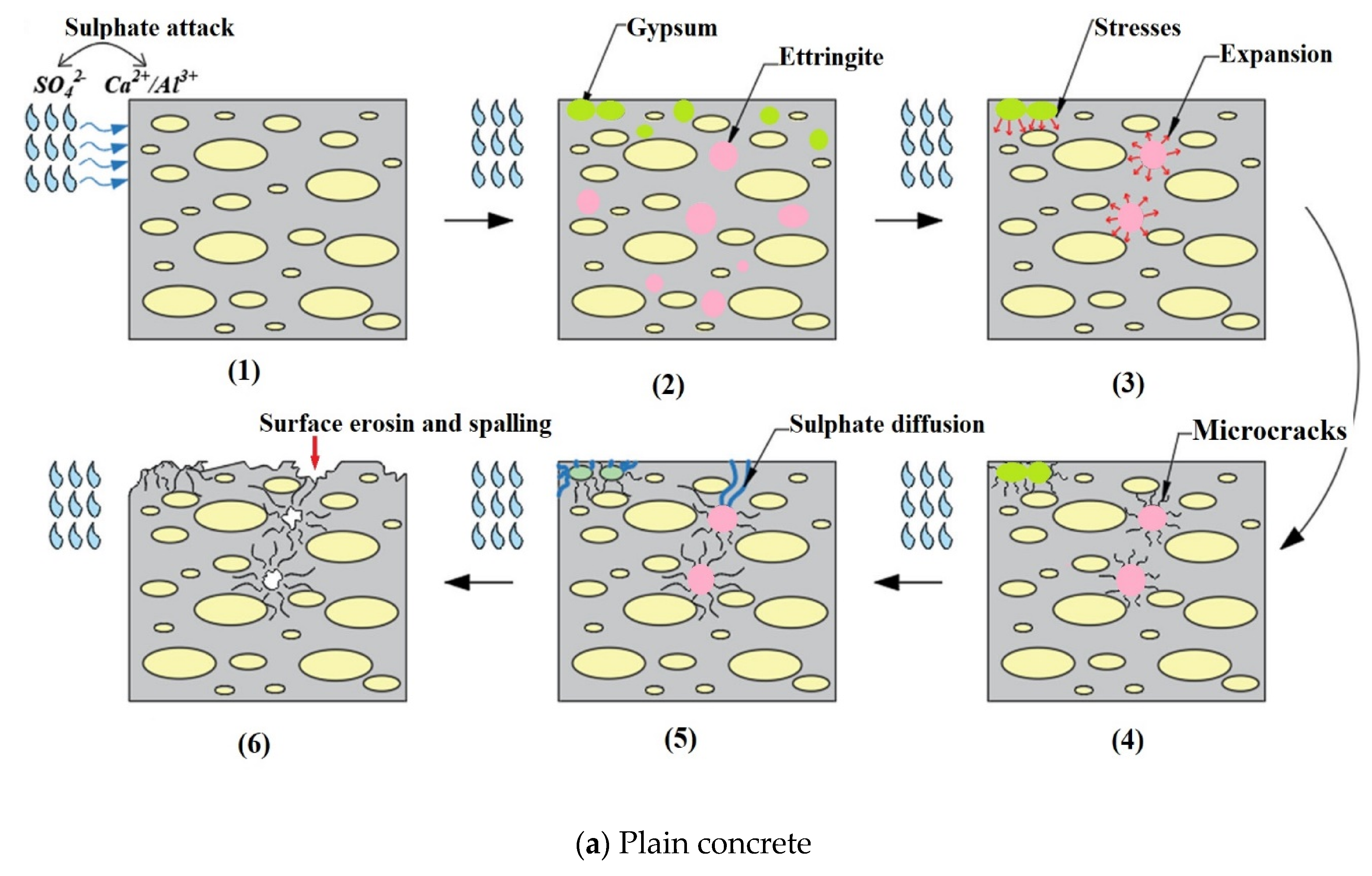

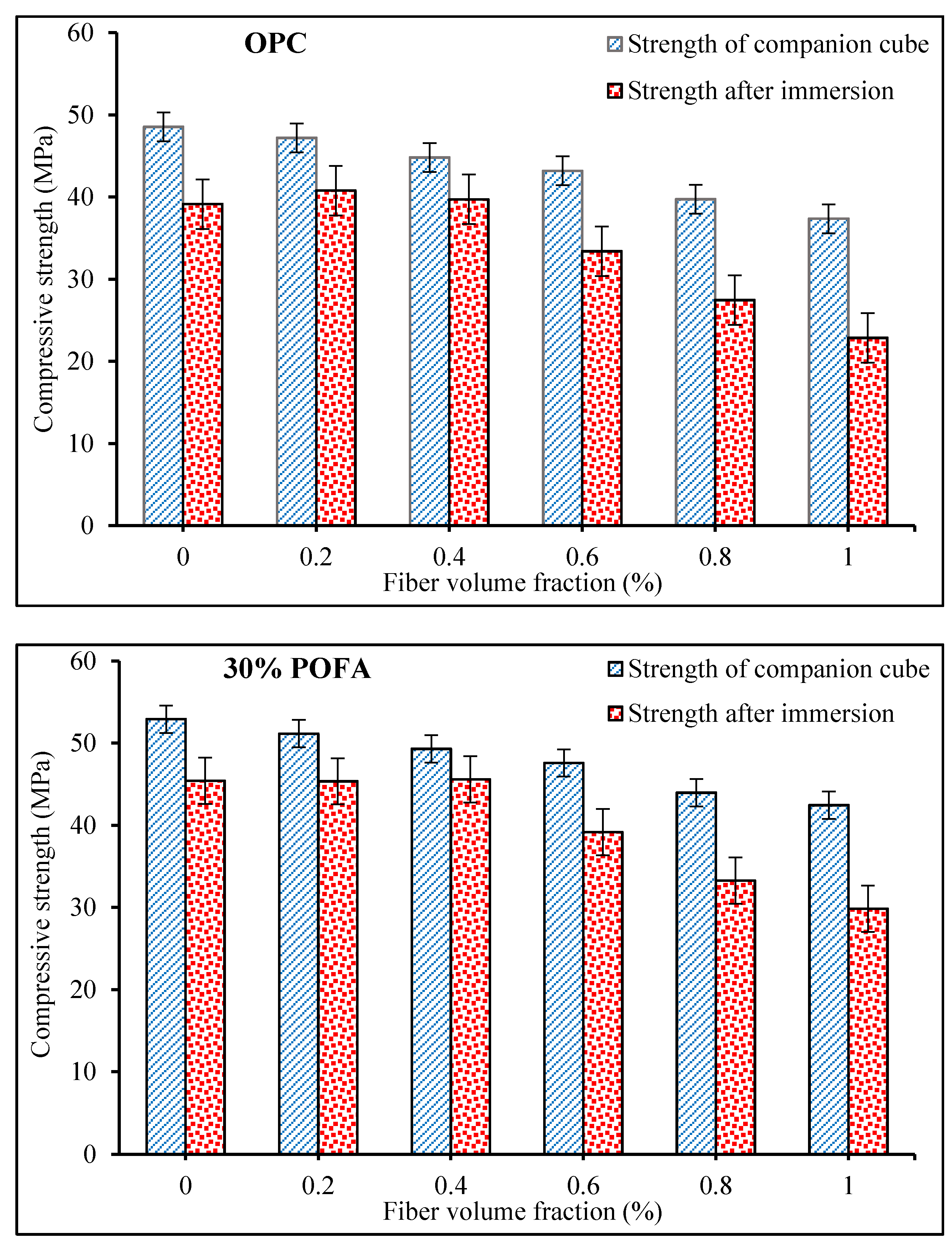
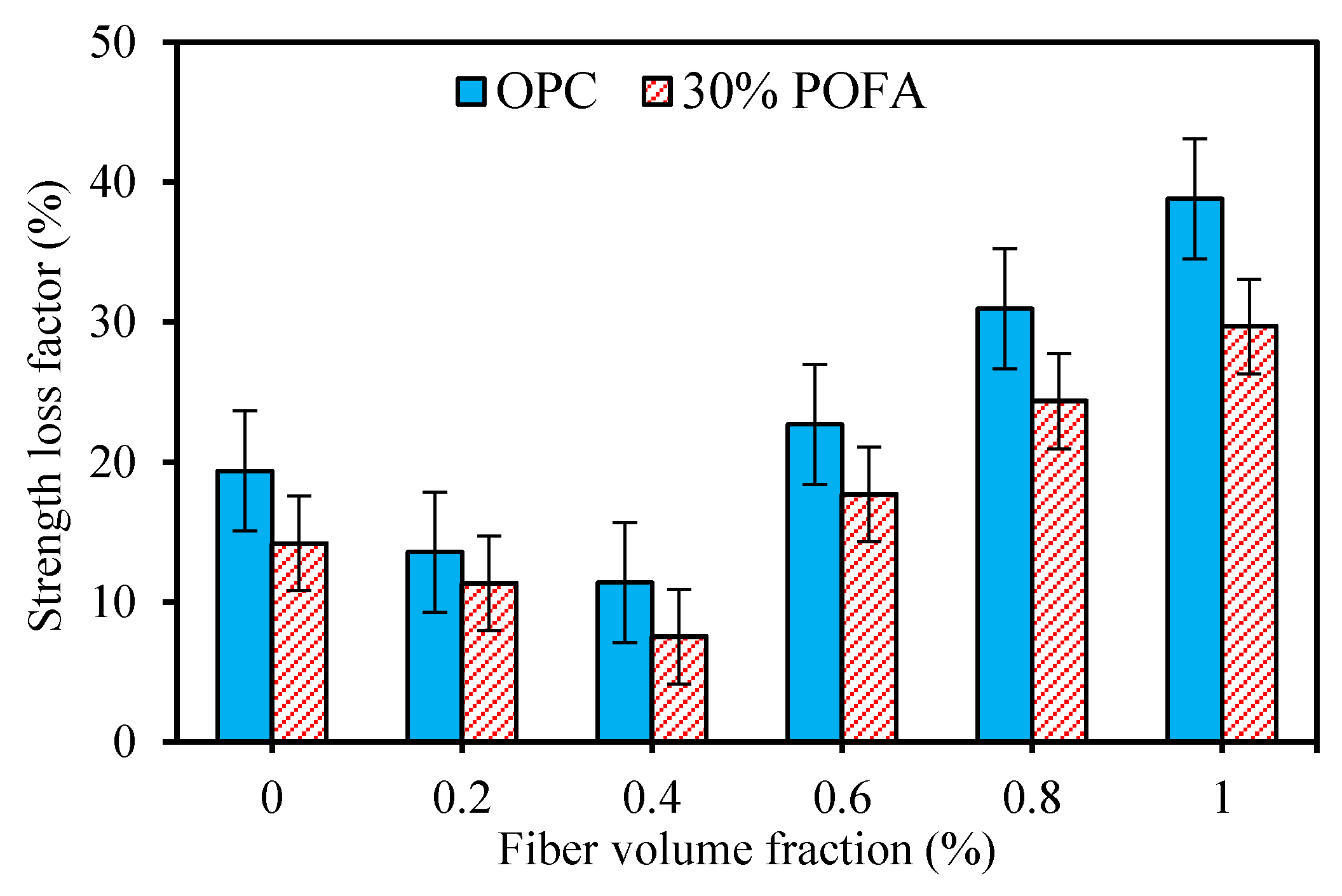
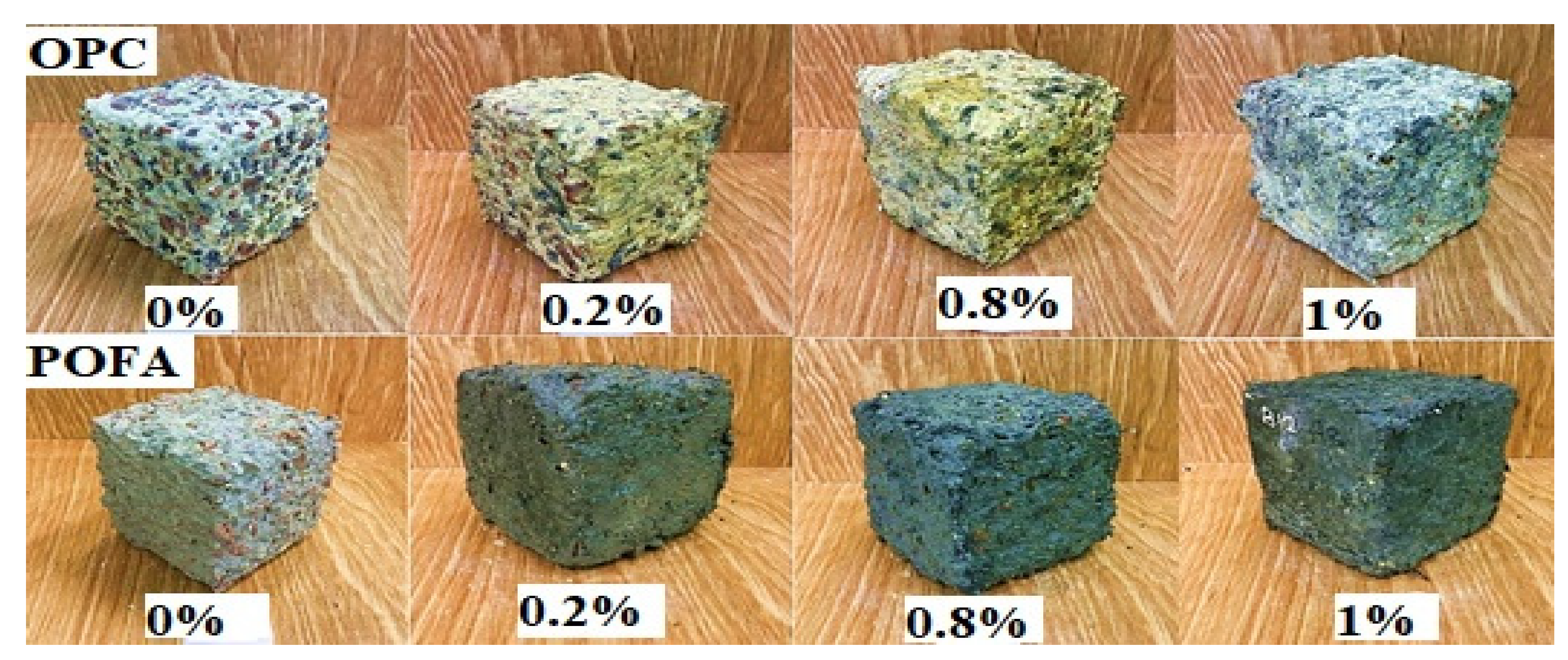
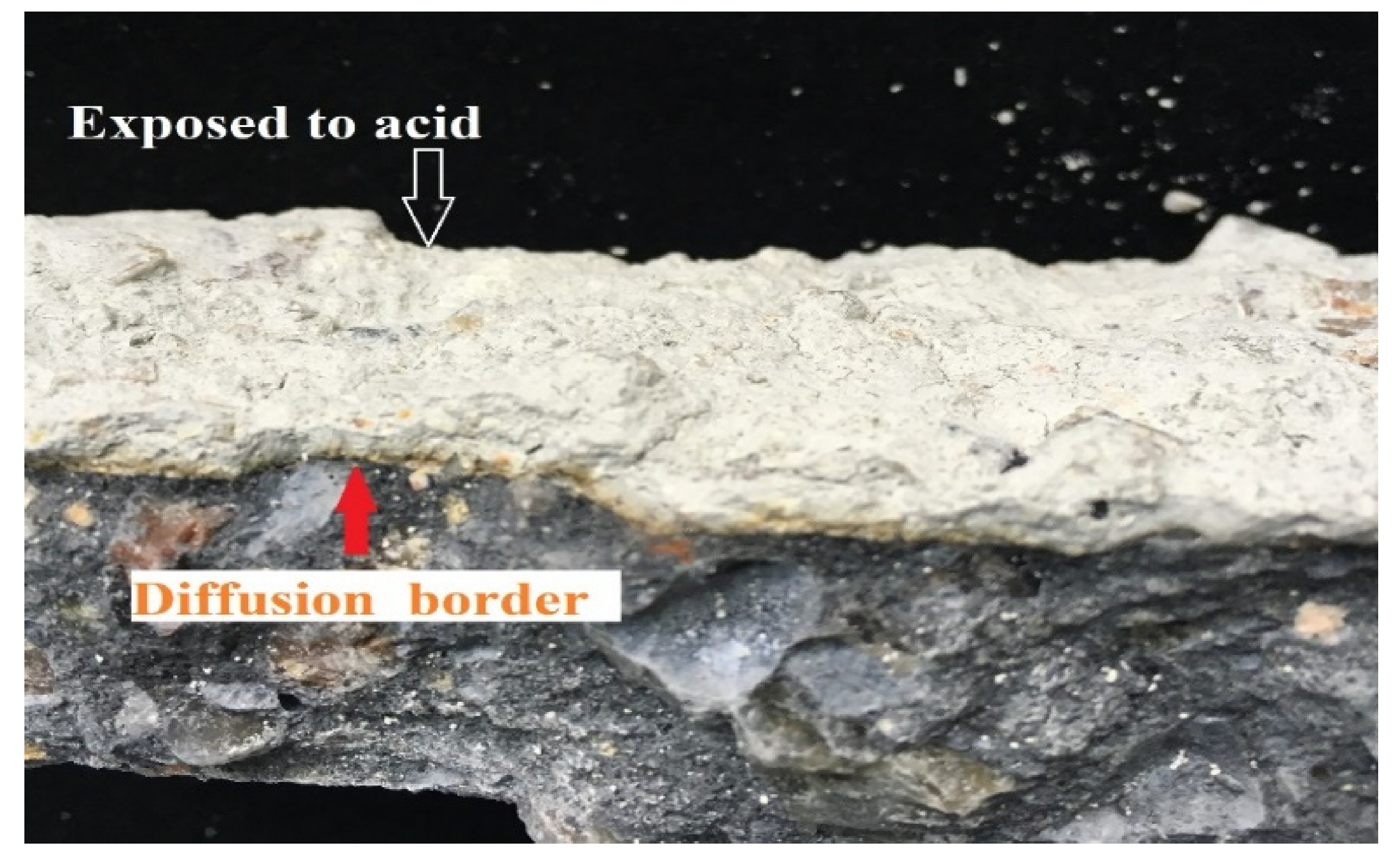
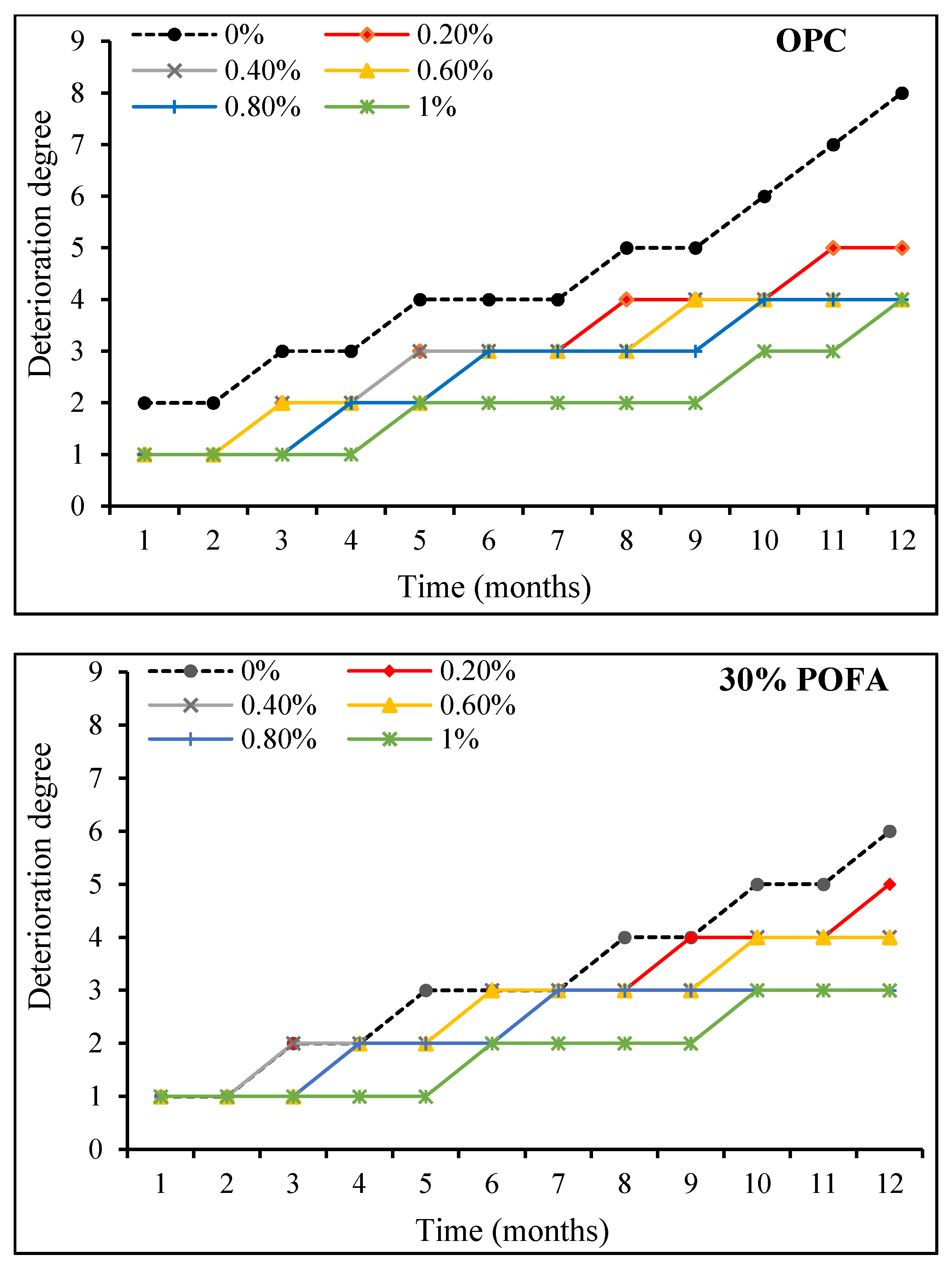
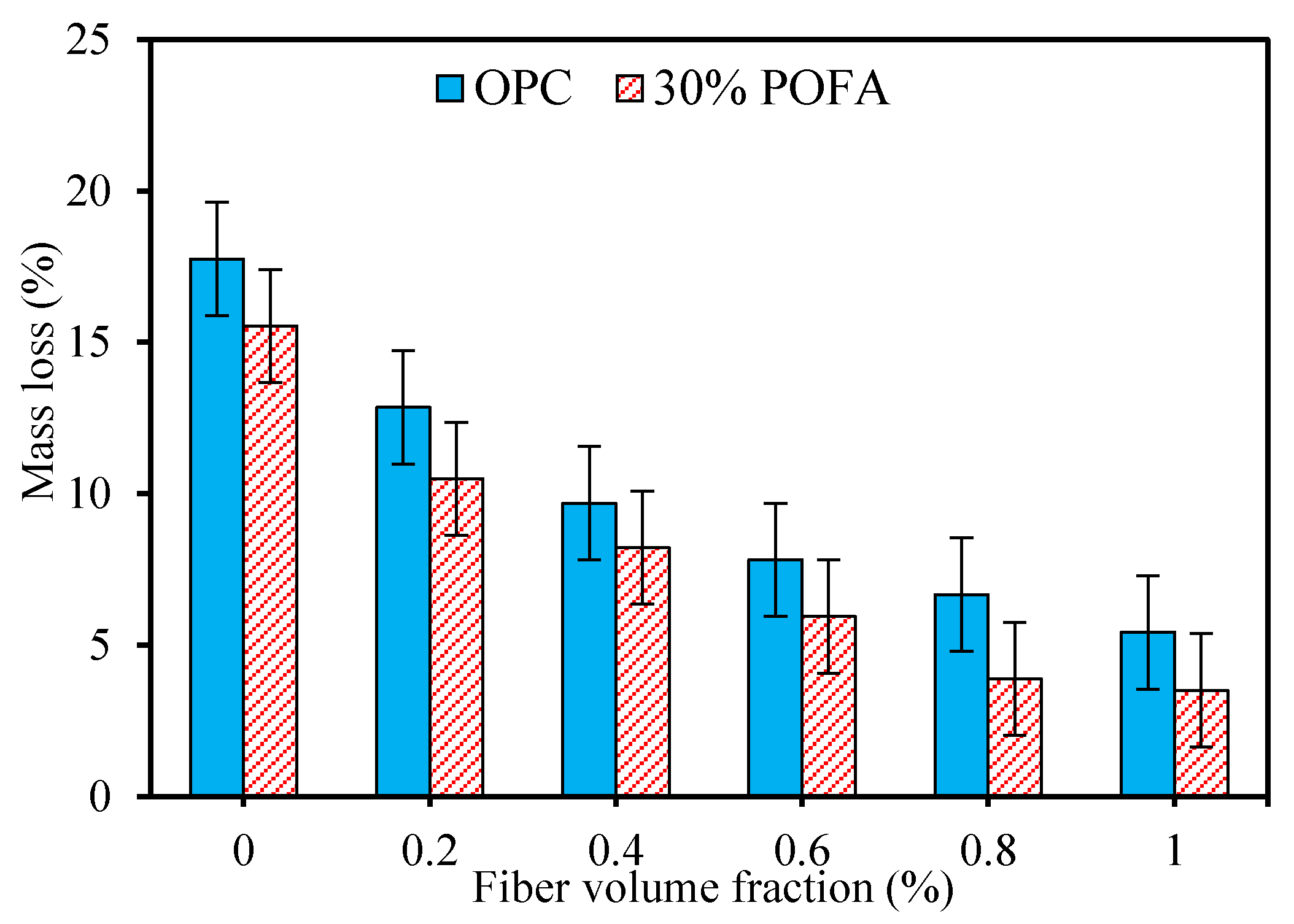


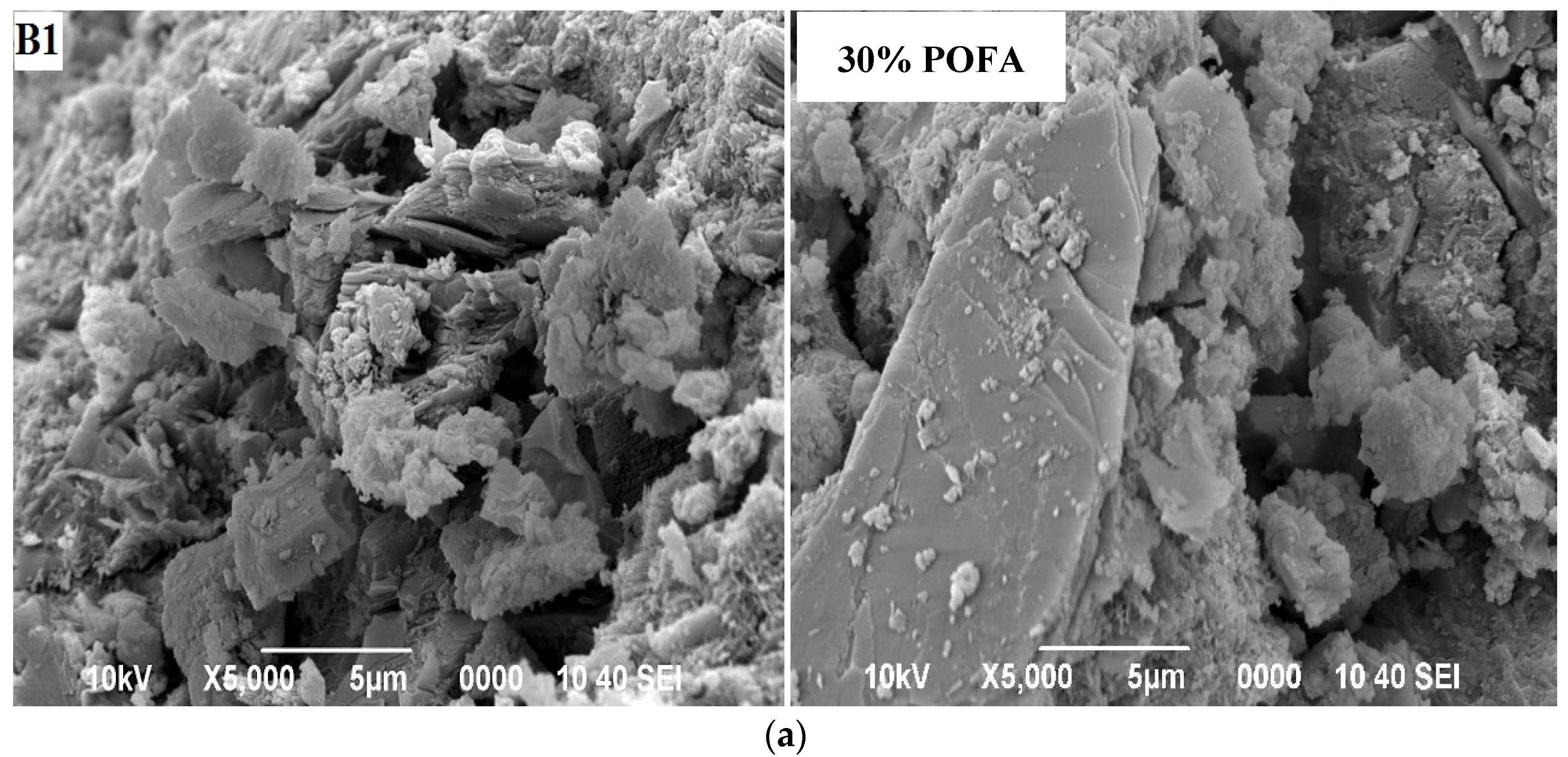
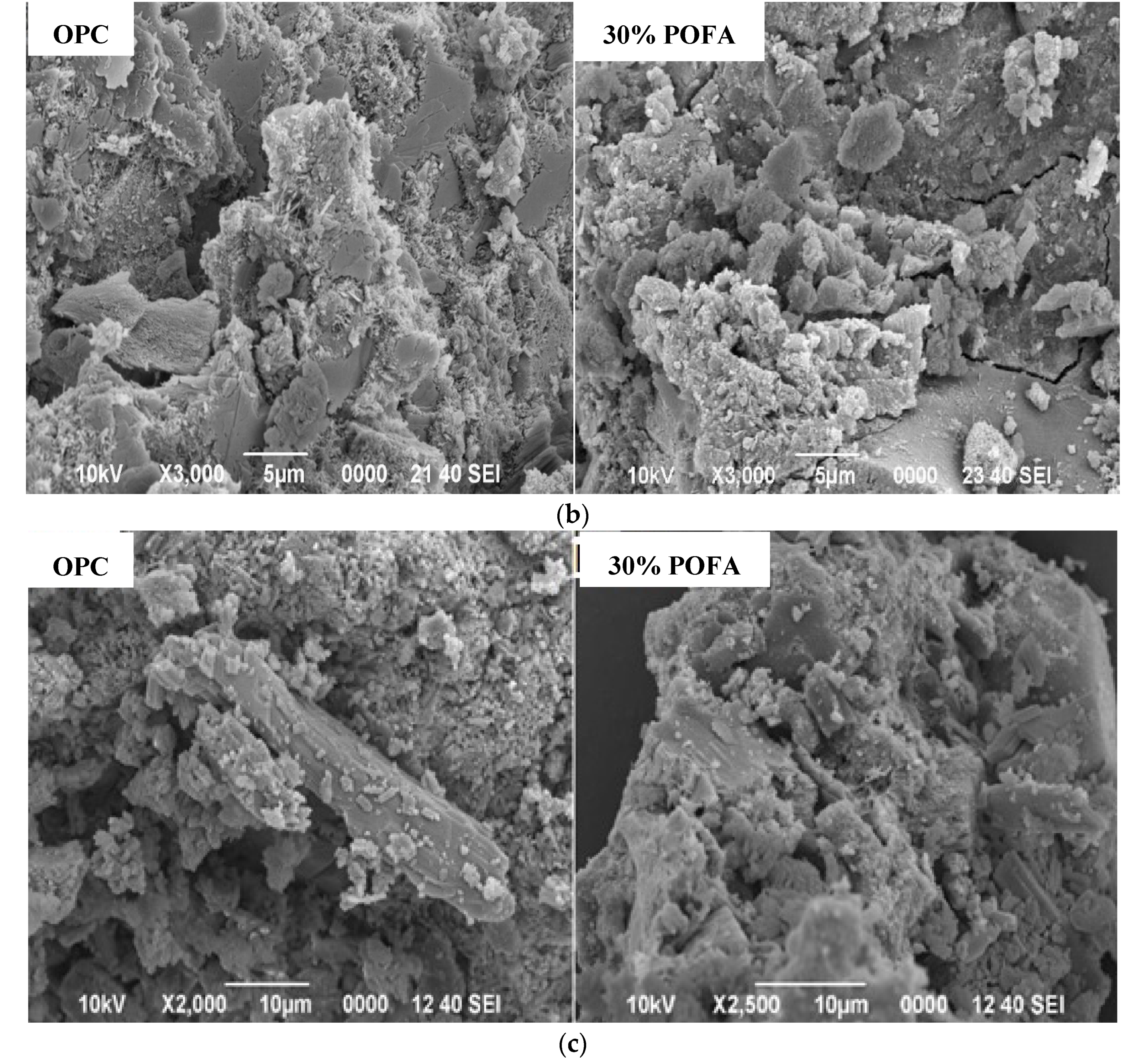
| Material | Physical Properties | Chemical Composition (%) | ||||||||
|---|---|---|---|---|---|---|---|---|---|---|
| Specific Gravity | Blaine Fineness | SiO2 | Al2O3 | Fe2O3 | CaO | MgO | K2O | SO3 | LOI | |
| OPC | 3.15 | 3990 | 20.4 | 5.2 | 4.19 | 62.4 | 1.55 | 0.005 | 2.11 | 2.36 |
| POFA | 2.42 | 4930 | 62.6 | 4.65 | 8.12 | 5.7 | 3.52 | 9.05 | 1.16 | 6.25 |
| Plastic Type | Strand Shape | Dimension (W × L) (mm) | Density Range (g/cm3) | Thickness (mm) | Tensile Strength (MPa) | Elongation (%) |
|---|---|---|---|---|---|---|
| Polypropylene | Rectangular | 2 × 20 | 0.94 | 0.3 | 550 | 7–10 |
| Mix | Cement (kg/m3) | POFA (%) | POFA (kg/m3) | Water (kg/m3) | Fine Aggregate (kg/m3) | Coarse Aggregate (kg/m3) | Vf (%) |
|---|---|---|---|---|---|---|---|
| B1 | 445 | - | - | 220 | 830 | 865 | - |
| B2 | 445 | - | - | 220 | 830 | 865 | 0.2 |
| B3 | 445 | - | - | 220 | 830 | 865 | 0.4 |
| B4 | 445 | - | - | 220 | 830 | 865 | 0.6 |
| B5 | 445 | - | - | 220 | 830 | 865 | 0.8 |
| B6 | 445 | - | - | 220 | 830 | 865 | 1.0 |
| B7 | 312 | 30 | 133 | 220 | 830 | 865 | - |
| B8 | 312 | 30 | 133 | 220 | 830 | 865 | 0.2 |
| B9 | 312 | 30 | 133 | 220 | 830 | 865 | 0.4 |
| B10 | 312 | 30 | 133 | 220 | 830 | 865 | 0.6 |
| B11 | 312 | 30 | 133 | 220 | 830 | 865 | 0.8 |
| B12 | 312 | 30 | 133 | 220 | 830 | 865 | 1.0 |
| Deterioration Scale | Observed Damages |
|---|---|
| 0 | No noticeable deterioration |
| 1 | Slight deterioration at edges in the form of microcracks |
| 2 | Deterioration at edges and corners |
| 3 | Cracking at corners and along the edges of samples |
| 4 | Severe cracks and expansion along the edges |
| 5 | Widespread cracks and sample expansion |
| 6 | Further expansion and side deterioration of samples |
| 7 | Wide expansion and spalling |
| 8 | Extensive deterioration and washout |
| 9 | Sample breakdown |
Publisher’s Note: MDPI stays neutral with regard to jurisdictional claims in published maps and institutional affiliations. |
© 2021 by the authors. Licensee MDPI, Basel, Switzerland. This article is an open access article distributed under the terms and conditions of the Creative Commons Attribution (CC BY) license (https://creativecommons.org/licenses/by/4.0/).
Share and Cite
Mohammadhosseini, H.; Alyousef, R.; Poi Ngian, S.; Tahir, M.M. Performance Evaluation of Sustainable Concrete Comprising Waste Polypropylene Food Tray Fibers and Palm Oil Fuel Ash Exposed to Sulfate and Acid Attacks. Crystals 2021, 11, 966. https://doi.org/10.3390/cryst11080966
Mohammadhosseini H, Alyousef R, Poi Ngian S, Tahir MM. Performance Evaluation of Sustainable Concrete Comprising Waste Polypropylene Food Tray Fibers and Palm Oil Fuel Ash Exposed to Sulfate and Acid Attacks. Crystals. 2021; 11(8):966. https://doi.org/10.3390/cryst11080966
Chicago/Turabian StyleMohammadhosseini, Hossein, Rayed Alyousef, Shek Poi Ngian, and Mahmood Md. Tahir. 2021. "Performance Evaluation of Sustainable Concrete Comprising Waste Polypropylene Food Tray Fibers and Palm Oil Fuel Ash Exposed to Sulfate and Acid Attacks" Crystals 11, no. 8: 966. https://doi.org/10.3390/cryst11080966
APA StyleMohammadhosseini, H., Alyousef, R., Poi Ngian, S., & Tahir, M. M. (2021). Performance Evaluation of Sustainable Concrete Comprising Waste Polypropylene Food Tray Fibers and Palm Oil Fuel Ash Exposed to Sulfate and Acid Attacks. Crystals, 11(8), 966. https://doi.org/10.3390/cryst11080966






